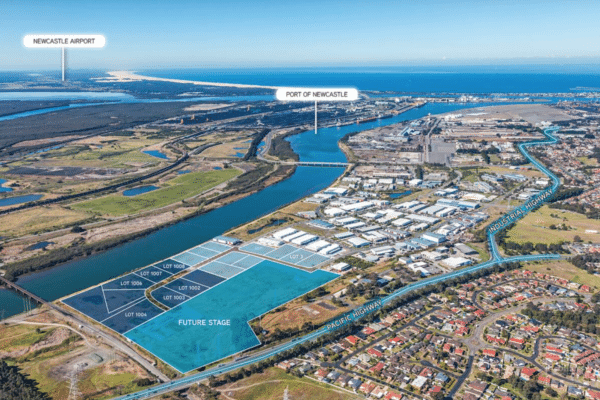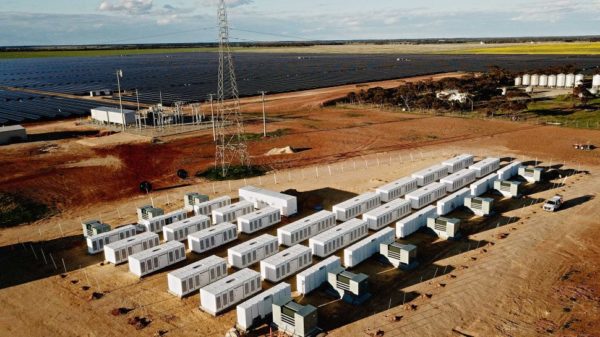A joint venture between Australian companies Edify Energy and Precinct Capital has lodged a development application with Newcastle City Council to build a utility-scale battery on 0.6 hectares of land within the Steel River Estate industrial area, on the South Channel bank of the Hunter River, in the Newcastle suburb of Mayfield West.
“Deploying this battery in the heart of Newcastle’s industrial precinct will help balance the power system for the city, keeping the lights on for industry and households throughout the region,” said Precinct Capital’s Chairman, Bruce Baudinet.
Although not directly associated with solar or wind generation, but intended to charge and discharge directly from the grid in response to disturbances or market signals, the 28 MW/56 MWh battery energy storage system (BESS) “will facilitate the further deployment of renewables by providing grid stabilisation”, Edify Energy’s Chief Executive John Cole, told pv magazine today.
He added, “The project is aligned with the objectives of the NSW Electricity Strategy and NSW Electricity Infrastructure Roadmap”, as well as with the Australian Energy Market Operator’s (AEMO’s) 2020 Integrated System Plan, all of which “call for dispatchable electricity technologies to enable a firmed renewable energy supply from Renewable Energy Zones”.
The Hunter region was recently identified as the state’s fifth key Renewable Energy Zone by the New South Wales Minister for Energy and Environment, Matt Kean, but remains some way down the planning track after the 3 GW Central West Orana and 8 GW New England REZs.
Steel River, pending development and planning approval will get ahead of the REZ curve, supporting in the short term both additional utility-scale renewables and rooftop solar penetration into the grid, to meet local and state renewable energy targets.

Image: Colliers International
From the Gannawarra school of hard knocks
Edify Energy is one of a handful of renewable energy investors and developers to have successfully brought a large-scale battery to the Australian energy market.
It is responsible for Victoria’s 25 MW/50 MWh Gannawarra Energy Storage System (GESS), the first such system to be retrofitted to work in tandem with a solar generator, in this case the 60 MW Gannawarra Solar Farm. Supported with grant funding by the Australian Renewable Energy Agency (ARENA) and the Victorian Government, it was commissioned in late 2018, and continues to deliver learnings on how batteries can be deployed.
“One of the things we’ve learned is the multi-use application of these lithium ion batteries and what they can do for the network,” says Cole, who adds, “It’s such a dynamic space at the moment, if you stand still for five minutes, everything’s changed.”
An operational report on the GESS released by Edify in August 2020 provided key insights into the asset’s first two six-month periods of operation, including that the battery’s “performance in the energy market … was assisted by highly volatile days, where the supply / demand balance was tight”; and that, “Regulation FCAS performance has exceed expectations and has been the stand-out revenue generating performer for the asset since becoming registered in June 2019″.

Image: Edify Energy
Steel River BESS is expected to be given the go ahead to begin construction in late 2021 or early 2022, by which time, Cole says, the price of battery technology will likely have fallen further, and markets will have evolved for “ancillary services that batteries can operate into”; the potential is always for capitalising on volatilities in the energy spot price, buying low and selling high, and network companies will increasingly contract for system support and grid stabilisation services.
“There are myriad ways” to contract batteries, says Cole. At Steel River, the company has already received interest “from utilities, retailers, even businesses looking to diversify into energy”, he adds.
Reading the writing on the factory wall
The project is the first of its type for Precinct Capital, a family office which has been investing in and developing business-parks, self-storage facilities and residential construction on Australia’s eastern seaboard since 1981.
A statement released by Precinct and Edify just before Christmas said, “The decision to build the battery followed research by Precinct Capital which pointed to a growing large-scale battery storage industry in Australia.
It recognised that the land it held within the Steel River Estate was suitable for battery development and strategically located close to large industrial energy users such as the Tomago aluminium smelter. Other high-energy neighbours include Horan Steel, Port Hunter Conveyors and Ullrich Aluminium.
Newcastle has become a sustainable beacon
Mayor of Newcastle, Nuatali Nelmes said the project aligns with the City of Newcastle’s objectives as outlined in its Climate Action Plan, for firming renewable energy supply and building resilience in the local electricity network.
The city has been a leader in sustainable practices, including powering many council facilities with solar, building the 5 MW Summerhill Solar Farm for its own supply and in January 2020 it became the first NSW Council to be powered by 100% renewable sourced electricity.
Construction of the new BESS is expected to take between six and nine months and will create around 20 jobs during that period, as well as opportunities for local subcontractors in civil works, electrical installation, landscaping and so on.
Tesla provided the battery technology at Gannawarra, and Cole says that for Steel River, Edify and Precinct Capital are in discussion with “a number of equipment providers”. The decision has not yet been made whether to go with a turnkey solution from one provider, or to take on development themselves, combining technologies from different OEMs.
Energy storage is not a stationary proposition
Edify Energy operates one of the largest portfolios of solar farms in Australia, including Darlington Point, Whitsunday, Hamilton, Gannawarra, Daydream and Hayman solar farms, and Cole says the company has learned that what it originally viewed as passive assets, must be viewed as dynamic participants in the NEM.
“They don’t operate like a conventional machine, or a large spinning mass. We’re bidding those power plants into the market every five minutes.”
Batteries he says will also be operated dynamically according to market needs and opportunities.
He likens the “generational” change of the Hunter region to that of Collinsville in Queensland, where Edify Energy operates four solar farms (those with “island” names in the list above): “That was a big coal mining town and the solar farms have been very well received up there — we’ve had every school student, primary and secondary, visit those solar farms. It’s all part of the transition,” he says.
This content is protected by copyright and may not be reused. If you want to cooperate with us and would like to reuse some of our content, please contact: editors@pv-magazine.com.









3 comments
By submitting this form you agree to pv magazine using your data for the purposes of publishing your comment.
Your personal data will only be disclosed or otherwise transmitted to third parties for the purposes of spam filtering or if this is necessary for technical maintenance of the website. Any other transfer to third parties will not take place unless this is justified on the basis of applicable data protection regulations or if pv magazine is legally obliged to do so.
You may revoke this consent at any time with effect for the future, in which case your personal data will be deleted immediately. Otherwise, your data will be deleted if pv magazine has processed your request or the purpose of data storage is fulfilled.
Further information on data privacy can be found in our Data Protection Policy.